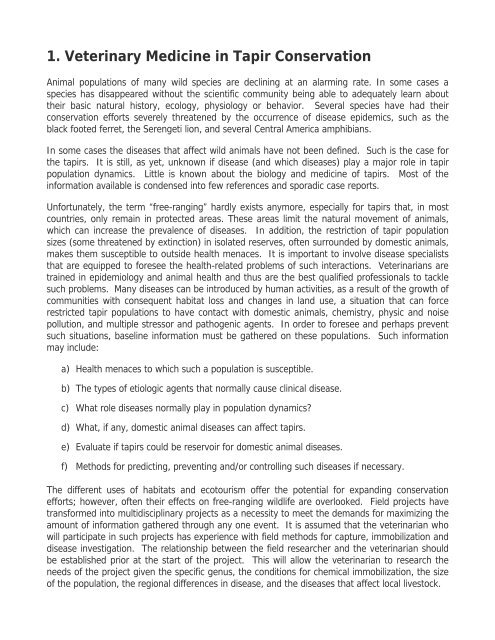TAPIR FIELD VETERINARY MANUAL - Tapir Specialist Group
TAPIR FIELD VETERINARY MANUAL - Tapir Specialist Group
TAPIR FIELD VETERINARY MANUAL - Tapir Specialist Group
Create successful ePaper yourself
Turn your PDF publications into a flip-book with our unique Google optimized e-Paper software.
1. Veterinary Medicine in <strong>Tapir</strong> Conservation<br />
Animal populations of many wild species are declining at an alarming rate. In some cases a<br />
species has disappeared without the scientific community being able to adequately learn about<br />
their basic natural history, ecology, physiology or behavior. Several species have had their<br />
conservation efforts severely threatened by the occurrence of disease epidemics, such as the<br />
black footed ferret, the Serengeti lion, and several Central America amphibians.<br />
In some cases the diseases that affect wild animals have not been defined. Such is the case for<br />
the tapirs. It is still, as yet, unknown if disease (and which diseases) play a major role in tapir<br />
population dynamics. Little is known about the biology and medicine of tapirs. Most of the<br />
information available is condensed into few references and sporadic case reports.<br />
Unfortunately, the term “free-ranging” hardly exists anymore, especially for tapirs that, in most<br />
countries, only remain in protected areas. These areas limit the natural movement of animals,<br />
which can increase the prevalence of diseases. In addition, the restriction of tapir population<br />
sizes (some threatened by extinction) in isolated reserves, often surrounded by domestic animals,<br />
makes them susceptible to outside health menaces. It is important to involve disease specialists<br />
that are equipped to foresee the health-related problems of such interactions. Veterinarians are<br />
trained in epidemiology and animal health and thus are the best qualified professionals to tackle<br />
such problems. Many diseases can be introduced by human activities, as a result of the growth of<br />
communities with consequent habitat loss and changes in land use, a situation that can force<br />
restricted tapir populations to have contact with domestic animals, chemistry, physic and noise<br />
pollution, and multiple stressor and pathogenic agents. In order to foresee and perhaps prevent<br />
such situations, baseline information must be gathered on these populations. Such information<br />
may include:<br />
a) Health menaces to which such a population is susceptible.<br />
b) The types of etiologic agents that normally cause clinical disease.<br />
c) What role diseases normally play in population dynamics?<br />
d) What, if any, domestic animal diseases can affect tapirs.<br />
e) Evaluate if tapirs could be reservoir for domestic animal diseases.<br />
f) Methods for predicting, preventing and/or controlling such diseases if necessary.<br />
The different uses of habitats and ecotourism offer the potential for expanding conservation<br />
efforts; however, often their effects on free-ranging wildlife are overlooked. Field projects have<br />
transformed into multidisciplinary projects as a necessity to meet the demands for maximizing the<br />
amount of information gathered through any one event. It is assumed that the veterinarian who<br />
will participate in such projects has experience with field methods for capture, immobilization and<br />
disease investigation. The relationship between the field researcher and the veterinarian should<br />
be established prior at the start of the project. This will allow the veterinarian to research the<br />
needs of the project given the specific genus, the conditions for chemical immobilization, the size<br />
of the population, the regional differences in disease, and the diseases that affect local livestock.










